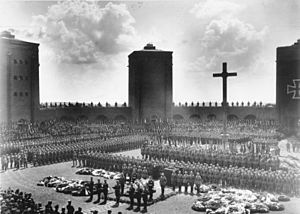Tannenberg Memorial facts for kids
Quick facts for kids Tannenberg Memorial |
|
|---|---|
| Olsztynek, present-day Poland | |

|
|
| Coordinates | 53°34′53″N 20°15′39″E / 53.58139°N 20.26083°E |
| Site information | |
| Open to the public |
Yes |
| Condition | Virtually all traces gone |
| Site history | |
| Built | 1924-1927 |
| Built by | Johannes and Walter Krüger, Berlin |
| Demolished | 1945, 1950, 1980s |
The Tannenberg Memorial was a special monument in Germany. It honored German soldiers who fought in important battles. The most famous was the Battle of Tannenberg (1914) during World War I.
The memorial also remembered the First Battle of the Masurian Lakes. It even honored the medieval Battle of Tannenberg (1410). A famous German leader, Generalfeldmarschall Paul von Hindenburg, was a hero from the 1914 battle. He was later buried at this site.
Contents
Building the Tannenberg Memorial
Why the Memorial Was Built
The memorial was built to remember the German victory. This victory happened at the Battle of Tannenberg in 1914. It was a very important battle for Germany.
General Hindenburg led the German army to success. He became a national hero because of this win. The memorial was a way to honor him and the soldiers.
Design and Construction
Hindenburg officially opened the memorial in 1924. This was 10 years after the big battle. The site was near a town called Hohenstein. Today, this town is Olsztynek in Poland.
People donated money to build the memorial. Two architects from Berlin, Johannes and Walter Krüger, designed it. They finished building it in 1927.
The memorial had a unique shape. It was an octagon, like a stop sign. It had eight tall towers, each 20 meters high. Its design was inspired by old buildings. These included Holy Roman Emperor Frederick II's Castel del Monte and even Stonehenge.
Changes and Demolition
Hindenburg's Burial at the Memorial
Reichspräsident Hindenburg passed away in 1934. His family wanted him buried in Hanover. But his coffin was placed at the Tannenberg Memorial instead. His wife, who died in 1921, was also buried there.
Adolf Hitler was in power then. He ordered changes to the monument. He also gave it a new name: "Reichsehrenmal Tannenberg." This means "Tannenberg National Memorial of Honor."
The Memorial's End
In 1945, the Red Army (Soviet troops) was getting close. German soldiers removed Hindenburg's remains. They also blew up parts of the memorial. They wanted to prevent it from falling into enemy hands.
After the war, in 1949, Polish authorities took down the rest. They completely removed the site. Today, very little remains of the Tannenberg Memorial.
Images for kids
-
Generalfeldmarschall Paul von Hindenburg
See also
 In Spanish: Monumento de Tannenberg para niños
In Spanish: Monumento de Tannenberg para niños





